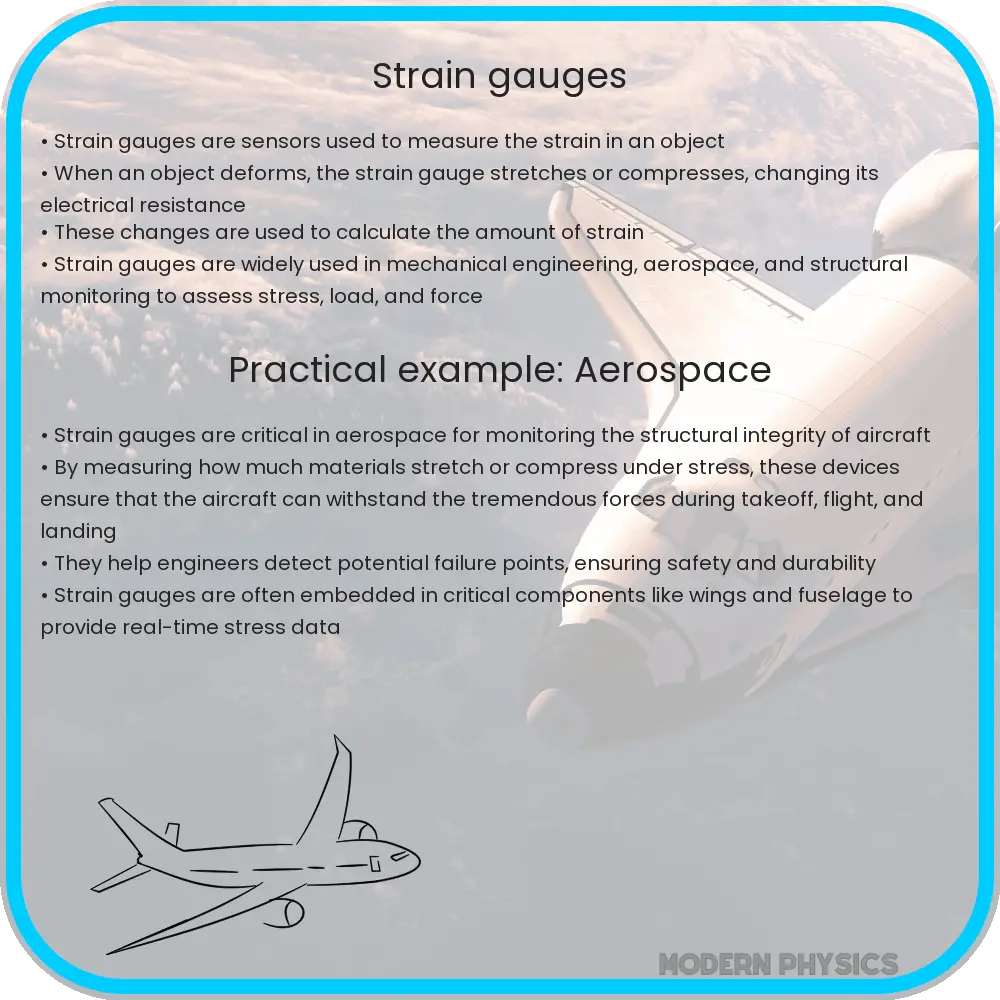Learn about strain gauges, devices used to measure the mechanical strain on objects by observing changes in electrical resistance, vital for stress analysis and earthquake detection.

Understanding Strain Gauges: Fundamental Concepts and Their Applications in Stress Analysis and Earthquake Detection
Strain gauges are instrumental devices used in the field of material science, engineering, and physics to measure strain on an object. The working principle behind a strain gauge involves its electrical resistance changing in response to mechanical strain. This simple yet powerful property makes them indispensable in various industrial and research applications.
The Basics of Strain Gauges
At the core of a strain gauge is a metallic foil arranged in a pattern on a non-conductive backing material. When an external force is applied to an object outfitted with a strain gauge, the object deforms, stretching or compressing the gauge. This mechanical change alters the length and diameter of the metallic foil, impacting its electrical resistance. This change in resistance is proportional to the strain experienced by the material, providing a measure of the strain through basic electrical principles.
- Resistance and Strain Relation: The relationship between resistance (R) and strain (ε) can be expressed using the gauge factor (GF), which is a property specific to each strain gauge. The formula to calculate the change in resistance is:
ΔR = GF * R0 * ε
where R0 is the original resistance.
- Types of Strain Gauges: Different kinds of strain gauges, including uniaxial, biaxial, and rosette, cater to various measurement requirements. Depending on the application, a specific type, shape, and orientation of the gauge are selected to accurately measure strains in different directions.
Precision in Strain Measurement
For high-precision measurements, the quality and type of the strain gauge play critical roles. Advances in material technology and manufacturing processes ensure that contemporary strain gauges offer impressively low tolerance levels and high durability, making them suitable for sensitive and long-term applications. Additionally, signal conditioning like temperature compensation and noise filtering are crucial for achieving precise strain measurements in real-world environments.
Applications in Stress Analysis and Material Testing
Strain gauges are pivotal in stress analysis in materials testing. Engineers and researchers attach the gauges to materials and structures under stress to verify theoretical models, simulate new designs, and validate safety standards. This technique is extensively used in crucial sectors such as aerospace, automotive, and civil engineering to predict failure points and enhance material properties.
Role of Strain Gauges in Earthquake Analysis
Strain gauges also play a vital role in geotechnical engineering, particularly in earthquake analysis. By installing these gauges along fault lines and on critical infrastructure like bridges and dams, researchers can monitor the minute precursory strains that precede earthquakes. This data is invaluable for predicting the timing and impact of seismic events, potentially saving lives and mitigating property damage through early warning systems.
Installation and Calibration of Strain Gauges
The installation of strain gauges is a delicate process that requires precision. Firstly, the surface of the object where the gauge is to be attached must be carefully prepared to ensure proper adhesion and signal integrity. Special adhesives are used to mount the gauge securely. After installation, calibration is crucial to ensure accurate readings. This involves setting the gauge to a baseline or zero strain condition and systematically applying known quantities of strain to establish a reliable relationship between electrical resistance changes and mechanical strain.
Maintenance and Challenges
Maintaining strain gauges involves regular checks and recalibrations to ensure consistent accuracy. Environmental factors such as moisture, temperature fluctuations, and mechanical wear can affect performance, requiring periodic adjustment and, sometimes, replacement. Moreover, interpreting data from strain gauges can be challenging, especially in complex loading environments where strains are not uniformly distributed.
Conclusion
Strain gauges are fascinating devices that bridge the gap between the physical and electrical worlds, turning mechanical deformations into measurable electrical data. From their principle of operation to their integration into various industrial and research applications, these tools are essential for engineers and scientists in fields like materials testing, structural analysis, and seismic research. Whether it’s to test a new car design or monitor an earthquake-prone region, strain gauges provide a critical layer of insight into the mechanical stresses that materials and structures endure. Their continuing evolution in terms of materials, technology, and application methods ensures that strain gauges will remain vital in the pursuit of industrial innovation and safety.
